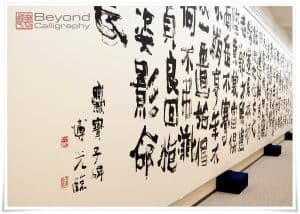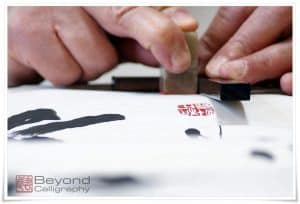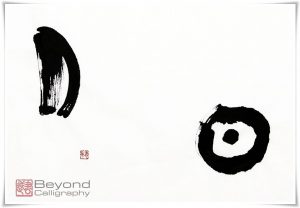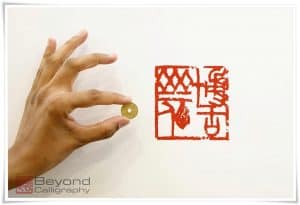Look up on a beautiful summer day and you will see the vast nothingness of blue skies, scattered clouds strolling lazily carried by a calm wind, and a blazing dot – the Sun, without which we would wander in darkness.

The philosophy of the ancient art of East Asian calligraphy is inseparable from nature and its forces. If you think of paper as the void or the sky (空, くう, kū), hovering above our heads like an infinite canvas, then Chinese characters (漢字, かんじ, kanji, lit ”characters of Han China”) would be the clouds traveling upon it. Drawing our sight to itself like an enchanted magnet, last, the warm dot on the sky would be the finishing touch added to complete a calligraphy work (作品, さくひん, sakuhin), concluding everything around it – the calligrapher’s seal.
Paper can be perceived to be infinite, its edges are only defined by our imagination. It’s a magical background which conveys the passion, a sine qua non element of calligraphy. Clouds may have random formations, and various types of clouds may coexist together in perfect harmony. The wind (風, かぜ, kaze) determines their shape, and in calligraphy, one’s personal handwriting (書風, しょふう, shofū), and the weather (mood that the calligrapher is in, or the nature of the text) determines their energy (気, き, ki, i.e. “spirit”).

The Sun has a designated path, and it lights everything up from various angles throughout the day. Without it all effort of life on Earth would be in vain. The positioning of the seal changes the mood of the work, just as the bright light of the rising or warm and pastel-like light of the setting Sun alters the world’s appearance, embracing it with its translucent arms.
Before the brush tip makes the first contact with the paper surface (起筆, きひつ, kihitsu, lit. “brush awakening”) the calligrapher ought to know where and how the main text will be written, where the signature will apppear, and last, where the seal will be placed. Calligraphy is the art of arranging white space (空白, くうはく, kūhaku, lit. “empty [void]) white”), wherein brush strokes and seals are the medium serving that very purpose. When you admire calligraphy, you should not focus on the characters at first, but rather at the white space and its beauty. In the presence of a masterpiece, you ought to soar the skies like a dragon, not walk the Earth like a mortal. If you do not take flight, you will remain blind to its beauty.

Seeing an excellent calligraphy work, my teacher will often say: “印まで作品でしょう!” (いんまでさくひんでしょう, in made sakuhin deshō), which means that it is “a (magnificent) calligraphy work right up to (the last touch, which is) the calligraphy seal.
Writing all of the characters in accordance with the ancient principles of calligraphy is but the beginning, the work does not end until the signature is written and the seal or seals are placed. While writing, you need to consider your signature placement and when signing, you have to remember about the placement of your seals. Forcing them to fit will not enhance the work. By comparison, seals are meant to compliment the work, not dominate it.
During calligraphy exhibitions, I often stand a few metres from a displayed work, cover the seal with one hand (holding my hand in the air), close one eye, and look just at the monochromatic reality to see whether or not the seal is covering mistakes or shortcomings. A good seal, when well-placed, can “save your” work. On the other hand, a badly placed seal, or a poorly carved one, can ruin a fantastic work.

I have noticed that for exhibition purposes, some students ask their teacher to press the seal for them. This is the worst thing a student can do, for without pressing it yourself, you will never learn how to do it. I press my seals on each work (or almost all) that I submit to my teacher for review. All together, the total is approximately 600 seals being pressed a month. I spend about 5-10 hours a month on seal pressing, depending upon how much time I have for writing.
There are certain rules of seal pressing which I will discuss in Part II of this article, but generally, the skill comes with practice. We learn it as we learn calligraphy through the study of rinsho (臨書, りんしょ, i.e. “copying [studying] masterpieces). We do it by observation, then trial and error. Following the rules is as important as following your artistic instinct. After some time and learning the basic rules of seal pressing, you will sense which place is the perfect spot for your seal, or what seal size should be used, etc.
